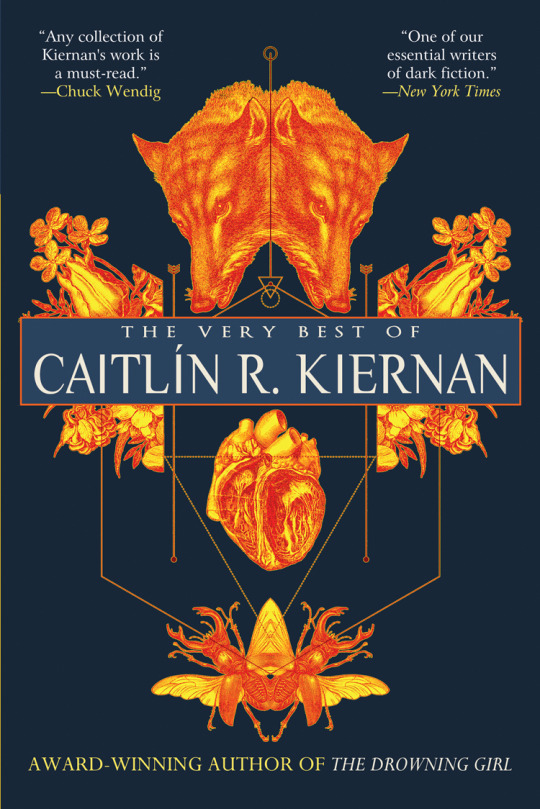The magnificent nightmares of THE VERY BEST OF CAITLÍN R. KIERNAN will f**king haunt you
A quintet of praise for THE VERY BEST OF CAITLÍN R. KIERNAN.

Photo: Kyle Cassidy
Shon Richards on their eponymous site loves the collection.
I would argue that anything Caitlin Kiernan writes is the very best but I am biased that way. This edition collects some really fabulous stories and I enjoyed every one of them. These stories are not just horror and weird fiction. These stories will fucking haunt you.
For STRANGE HORIZONS, Duncan Lawie both enjoys and is exhausted by the unforgettable stories.
The result is that this can be an exhausting collection to read. Almost every story asks for close attention, for serious and thoughtful engagement with the text. They start and end in strange places; they are confusing; they strive for mood over plot, feeling over revelation. But they reward that necessary close attention. Perhaps they don’t explain themselves, but there is often a purpose that can be sensed, a satisfaction found in puzzling something out of the material presented. There are lovely turns of phrase, powerful images, and beautiful sentences. There are exacting descriptions which indicate that, when something is vague, it is because Kiernan wishes it to remain so. Sometimes there is even a sense of relief in the ending—even if this is simply that the grimmest thing hasn’t happened.
<snip>
With 250 stories to Kiernan’s name, it is impossible for this reader to tell how representative these are of her fiction career of nearly thirty years. Indeed, even within this collection I have named fewer than half the available stories, but I hold each of them close—except the ones I want to forget, and those seem to hold on to me.

Annette Lapointe at NEW YORK JOURNAL OF BOOKS likes the book.
Within this darkness, a new infection emerges. An alien thing, it occupies bodies and shifts them into new, horrifying modes: “this incomplete, demonic biology. [The infected] were each no more than appendages now, human beings become coalesced obligate parasites or symbiotes, their glinting, chitinous bodies all but lost in a labyrinth of mucosal membranes, buried by the array of connective tissues and tubes that sprouted from them like cancerous umbilical cords.” The layers of sex and motherhood linked to the disease only expand the nightmare. Most crucially, this state is something the women seek out. They ask for the infection; they transform themselves.
These magnificent nightmares rise out of Kiernan’s work and infect the brain of the reader. If her work is infectious, so far only the restrictions of genre publishing have prevented an epidemic. Yet, like the Fenrir virus of “Bradbury Weather,” that infection is something we can choose; it might even be desirable. The alienness is seductive. In a terrible world (the world is terrible; that chandelier used to be a medical student: she chose this, too), we inevitably desire terrible things. New terrors are what Kiernan offers, for worse, but for transformative worse.
On LOCUS, Gary K. Wolfe reviews the volume.
THE VERY BEST OF CAITLÍN R. KIERNAN, a title apparently meant to avoid confusion with the two volumes of The Best of Caitlín R. Kiernan published by Subterranean in 2011 and 2015, is probably as good a one-volume introduction to the variety of Kiernan’s work as we’re likely to get, though it draws almost entirely on the last 15 years of her career (with only one earlier story, from 2003). While there are certainly some worthwhile earlier stories, there’s an argument to be made that Kiernan, who has been consistently maturing as an author since the ’90s, really found her voice and her strongest themes in the early years of this century. The lyricism and striking imagery are still there, but what at times seemed an infatuation with style has given way to an approach that is somehow more disciplined and more experimental at the same time, as though a brilliant improvisational dancer had learned choreography. Kiernan has often made use of dreamlike imagery, but it takes a good deal of narrative confidence to get away with a story like “In View of Nothing”, the most purely dreamlike tale here, which preserves the odd narrative shifts of an actual dream while maintaining its emotional focus on the two women, one a failed assassin and the other an amputee who seems to represent some sort of authority, who are basically talking in a room for most of the story.
Paul StJohn Mackintosh on his eponymous site lauds the publication and author.
What this compilation does demonstrate is that Caitlín R. Kiernan is producing the very best of contemporary dark and weird fiction, regardless of whether or not that typifies her whole range. She not only has written more than nine-tenths of her contemporaries, she has also written substantially better than nine-tenths of them. She casually throws off metaphor and imagery in passing that would make any other writer’s career. Kiernan has a word horde as rich as Smaug’s, and a voice as mesmeric.
<snip>
In their introduction to The Weird, Ann and Jeff VanderMeer write that Kiernan has “become perhaps the best weird writer of her generation.” There’s only two parts to that statement I’d question: Only weird? And perhaps? Weird fiction as a genre, if it is a genre, should be grateful to be able to lay even partial or intermittent claim to her. Caitlín R. Kiernan is the fulfilment of every weird fiction pundit’s dream of a transgressive, inclusive, brutally contemporary author who brings all the territory’s sub-genres bang up to date while ditching their historical baggage – yet she effortlessly transcends such categories and limitations, just as she effortlessly transcends every genre she’s cared to touch down in. Even after successive World Fantasy Awards and Bram Stoker Awards, she’s still a writer who can’t be honoured and recognized enough. Words fail me. But they rarely if ever fail her.
For more info about THE VERY BEST OF CAITLÍN R. KIERNAN, visit the Tachyon page.
Cover by Hannes Hummel
Design by Elizabeth Story


